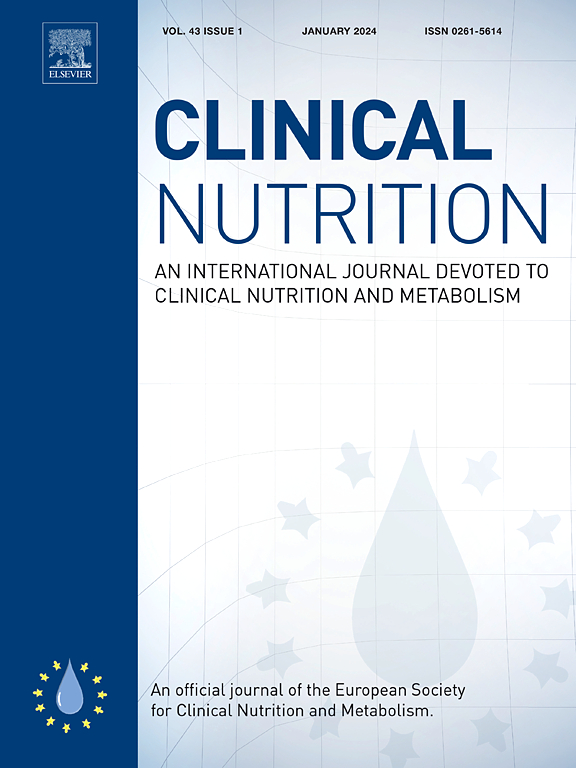相位角作为肌肉质量的标志:系统回顾和荟萃分析。
IF 6.6
2区 医学
Q1 NUTRITION & DIETETICS
引用次数: 0
摘要
背景与目的:相位角(PhA)是一种生物标志物,由生物电阻抗分析(BIA)原始值:电阻(R)和电抗(Xc)得出。PhA 反映了细胞膜的完整性,因此被认为是体液分布的标志物,是一个潜在的预后指标。越来越多的研究表明,PhA 与肌肉力量、质量和成分之间存在独立联系。在这种情况下,PHA 更有可能成为肌肉质量的标志物。然而,支持将其用于此目的的证据并不充分。本研究旨在调查 PhA 与肌肉质量指标之间的关系:这项系统性综述和荟萃分析(内部系统性综述前瞻性注册--PROSPERO,注册代码:CRD4202450785)的目的是研究 PhA 与肌肉质量指标之间的关系:CRD42024507853)侧重于评估PhA与肌肉质量两个概念的标志物之间关系的观察性研究:肌肉质量指数(MQI:按质量单位计算的力量)和肌肉组成(即骨骼肌放射性密度[SMD]、肌肉回声性、肌肉脂肪率、肌肉间和肌肉内脂肪率)。偏倚风险采用纽卡斯尔-渥太华量表(NOS)和诊断准确性研究质量评估2(QUADAS-2)进行评估,证据的确定性采用建议评估、发展和评价分级(GRADE)方法进行评估。采用随机效应模型进行了元分析:本系统综述共纳入 17 项研究,涉及 2710 名参与者。元分析表明,PhA 与 SMD 呈中度正相关系数(4 项研究,924 名参与者;r = 0.54,95 % 置信区间 (CI) 0.38 至 0.69,异质性 (I2) = 92 %),对低 SMD 的分类具有良好的准确性(85 %)(2 项研究,390 名参与者;曲线下面积 - AUCpooled 0.85,95 % CI 0.78 至 0.92,I2 = 0 %)。PhA 与肌肉回声呈中度反相关(8 项研究,1401 名参与者;r = - 0.42,95 % CI - 0.57 至 - 0.24,I2 = 82 %),与 MQI 呈弱正相关(2 项研究,191 名参与者;r = 0.36,95 % CI 0.21 至 0.49,I2 = 17 %)。所有研究的偏倚风险都较高。证据的确定性从低到极低不等:尽管存在技术上的挑战,但这项研究证明了 PhA 作为肌肉质量替代标记物的潜力,尤其是在表达肌肉成分(SMD)方面。未来的研究应利用 BIA 标准化方案来确定 PhA 的特定临界值,从而提高其诊断准确性和临床适用性。这些研究还可以探索 PhA 和肌肉质量之间的关联机制。在技术因素不易控制的情况下,使用标准化 PhA(SPhA)将 PhA 转换为 Z 分数可能会有所帮助。虽然这还需要研究,但这种方法(SPhA)有可能考虑到年龄、性别、设备差异和健康状况等变量。本文章由计算机程序翻译,如有差异,请以英文原文为准。
Phase angle as a marker of muscle quality: A systematic review and meta-analysis
Background & aims
Phase angle (PhA) is a biomarker derived from raw bioelectrical impedance analysis (BIA) values: resistance (R) and reactance (Xc). PhA reflects cellular membrane integrity and, as a result, has been considered a marker of fluid distribution, making it a potential prognostic indicator. A growing body of research demonstrates independent associations between PhA and muscle strength, mass, and composition. In this context, PhA has the extra potential to serve as a marker of muscle quality. However, the evidence supporting its use for this purpose is not well established. This study aimed to investigate the relationship between PhA and markers of muscle quality.
Methods
This systematic review and meta-analysis (Internal Prospective Register of Systematic Reviews – PROSPERO on a registration code: CRD42024507853) focused on observational studies assessing the relationship between PhA and markers of both concepts of muscle quality: the muscle quality index (MQI: strength by a unit of mass) and the muscle composition (i.e., skeletal muscle radiodensity [SMD], muscle echogenicity, muscle fat fraction, inter- and intramuscular adiposity). Risk of bias was assessed using the Newcastle–Ottawa Scale (NOS) and Quality Assessment of Diagnostic Accuracy Studies 2 (QUADAS-2), while the certainty of evidence was evaluated using the Grading of Recommendations Assessment, Development, and Evaluation (GRADE) approach. Meta-analyses with a random-effects model were conducted.
Results
Seventeen studies were included in this systematic review, encompassing 2710 participants. Meta-analyses demonstrated that PhA had a moderate positive correlation coefficient with SMD (4 studies, 924 participants; r = 0.54, 95 % confidence interval (CI) 0.38 to 0.69, heterogeneity (I2) = 92 %) and good accuracy (85 %) for classifying low SMD (2 studies, 390 participants; Area Under the Curve – AUCpooled 0.85, 95 % CI 0.78 to 0.92, I2 = 0 %). PhA was inversely-moderately correlated with muscle echogenicity (8 studies, 1401 participants; r = - 0.42, 95 % CI - 0.57 to - 0.24, I2 = 82 %) and positively-weakly correlated with MQI (2 studies, 191 participants; r = 0.36, 95 % CI 0.21 to 0.49, I2 = 17 %). All studies had a higher risk of bias. The certainty of evidence ranged from low to very low.
Conclusion
Despite technical challenges, this study demonstrates the potential of PhA as a surrogate marker for muscle quality, particularly expressing muscle composition (SMD). Future studies should utilize BIA with standardized protocols to potentially establish specific cutoff values for PhA, thereby enhancing its diagnostic accuracy and clinical applicability. These studies could additionally explore the mechanisms underlying the associations between PhA and muscle quality aspects. In cases where technical factors are not easily controlled, the use of standardized PhA (SPhA), which converts PhA into Z-scores, could be beneficial. Although this warrants investigation, this approach (SPhA) has the potential to account for variables such as age, sex, device differences, and health status.
求助全文
通过发布文献求助,成功后即可免费获取论文全文。
去求助
来源期刊

Clinical nutrition
医学-营养学
CiteScore
14.10
自引率
6.30%
发文量
356
审稿时长
28 days
期刊介绍:
Clinical Nutrition, the official journal of ESPEN, The European Society for Clinical Nutrition and Metabolism, is an international journal providing essential scientific information on nutritional and metabolic care and the relationship between nutrition and disease both in the setting of basic science and clinical practice. Published bi-monthly, each issue combines original articles and reviews providing an invaluable reference for any specialist concerned with these fields.
 求助内容:
求助内容: 应助结果提醒方式:
应助结果提醒方式:


